Using Science Games to Deepen Learning Transcript
GFX:
Teaching Channel
+++ 00:00:04 +++
Barbara McCoy: Good morning, come in, sit down. Get your daily quiz out.
Barbara McCoy: When a student comes to see you and tells you that now they like science when they didn't like it before, it just really-- it's the reason why you teach.
Card:
Insert Title Here
Insert Subtitle Here
Barbara McCoy: Okay, today we're going to model the flow of energy. How is energy lost or gained in a food chain?
Barbara McCoy: The lesson today was about a flow of energy.
Lower Third:
Barbara McCoy
8th Grade Science Teacher
Webb Middle School, Garland, Texas
+++ 00:00:33 +++
Barbara McCoy: The students, prior to this, have learned about food chains and food webs, and they know that they gain energy by eating, but they don't think about how they lose energy. They don't think about those kinds of things, so this is actually going into more depth.
Barbara McCoy: Number one, how does your body use energy? Anybody? How does your body use energy?
Student: By moving?
Barbara McCoy: Okay, by moving. Anybody else?
Student: During sleeping.
+++ 00:00:56 +++
Barbara McCoy: Even when you're sleeping, you're using energy, okay? When you're breathing, because your heart is still beating. The blood is still going through your body. Your body's always using energy. Okay, let's go ahead and open our notebook to page number seven. We're going to take some Cornell notes.
+++ 00:01:12 +++
Barbara McCoy: Cornell notes is just a way for kids to solidify what they're learning, to question what they're learning and then to summarize what they're learning.
Barbara McCoy: I need you guys to copy this down, okay. We're going to be modeling the flow of energy. How is energy lost or gained in a food chain?
Barbara McCoy: We had them write down in the Cornell notes what the expectation was that they were going to learn and internalize by the end. And then also have them question what these organisms are in a food chain.
+++ 00:01:44 +++
Student: When was this the most energy? Because it's the plants and a lot of animals eat them.
Barbara McCoy: Sometimes I give them information. Like today, I gave them a list of the organisms. But then they also have to question what they're learning and so they write down a question that goes with the answer.
Barbara McCoy: Let's focus a little bit more on the energy side. Justin?
Student: Where does the lost energy go to?
Barbara McCoy: Where does the lost energy go to? So everyone write that down. Elise, what do you got?
Student: What is the producer of the food chain?
Barbara McCoy: What is the producer? Very good. Everyone, write it down.
+++ 00:02:15 +++
Barbara McCoy: After we got the lesson introduced with the Cornell notes, then I have to model what the kids are going to do.
Barbara McCoy: Everyone got a baggie and in that baggie is an organism. I want everyone to take that organism and put it around your neck like a necklace and I want to you write down who you are at the top. Okay, now everyone is starting off with 15 beans. What do you think the beans represent?
Students: Energy.
Barbara McCoy: Energy, okay? Now there are rules to playing this game.
+++ 00:02:43 +++
Barbara McCoy: The game is a flow of energy, the beans being the energy. They have to interact with all the different people in the classroom, all the different organisms and when they do that, they find that they don't always gain energy, but they're always going to lose energy.
Barbara McCoy: You're going to be kind of playing speed dating, only using energy, okay? So we're going to be going around and you're going to meet somebody. You're going to mark off their number on your paper and if you eat the algae-- are you algae? Okay, so if I ate the algae, then I would get five of her beans. That would mean I'm a pond snail and I would need to get five of her beans. After we finish meeting each other, we both put two beans in the waste bucket.
+++ 00:03:26 +++
Barbara McCoy: We had the algae, we had the snail, we had the tadpoles, the bass and the heron in this particular lesson. And so the heron would eat the bass and only get energy from the bass. The bass would eat the tadpoles and only get energy from there. The tadpoles ate the snails and only got energy from there and only the snails got energy from the algae. And the algae, constantly replenishing their energy from the sun.
+++ 00:03:53 +++
Barbara McCoy: Okay, remember if you are algae, every time you meet somebody and you've interacted, go back and get your beans, okay? Don't meet five people and then come back there, okay? All right, let's stand up and let's play. Go meet somebody, mark them off. You may begin.
Student: Who are you?
Student: I am algae.
Student: Okay, so I eat you because I'm a tadpole, right?
Barbara McCoy: You meet him and you are algae, so you can eat the tadpole.
Student: So you get five of my beans.
Student: Okay, and then we put down two.
Barbara McCoy: You need to mark each other off.
+++ 00:04:21 +++
Student: Okay, you're a tadpole?
Student: Yeah, I'm a tadpole. What are you again?
Student: Pond snail.
Barbara McCoy: You're algae, right?
Student: Yeah.
Barbara McCoy: But you did an interaction with her. Yes, each interaction, you go ahead and get some more beans. What number were you, 30?
Student: Thirty.
Barbara McCoy: Number 30, so put a check mark on number 30. Okay. Every time you meet somebody, you need to head to the back and get some more energy, okay? Every single time. Okay, what happens if you run out of beans?
+++ 00:04:51 +++
Student: I think I'm dead.
Barbara McCoy: You're dead.
Student: Oh no.
Student: Hey, put down 14.
Student: You eat me.
Student: What number are you?
Student: Number 28.
Student: Twenty-eight?
Student: You're 29.
Barbara McCoy: Once they get into the game, they get really excited. They love going around and gaining energy and losing energy.
Student: There we go. Never mind, oh, you're good. Okay.
Student: I need energy.
+++ 00:05:14 +++
Barbara McCoy: Remember, if you run out of beans, you're dead, okay. You have no more energy left.
Student: You check me off? Okay.
+++ 00:05:29 +++
Barbara McCoy: I think it's a really good game to play because students, they know what it looks like, the flow of energy, drawing the energy line, but they don't really understand it. They don't realize that every time you're interacting, you're losing energy as well. They don't get that when the grass partially dies, it will grow back. These are some fundamental things that they don't get by just looking at a food chain or a food web on a sheet of paper.
+++ 00:05:54 +++
Barbara McCoy: Okay, we're going to go ahead and shut it down. Finish your transaction and then have a seat.
Student: Count the beans.
Barbara McCoy: I do have to cut it off, because I need to make sure that I have enough time to wrap up.
Barbara McCoy: I need everyone to count how many beans you have and then write it down at the bottom of this page.
Barbara McCoy: Then you tally the total number of beans. So we went around and did that very quickly and then we recorded that.
Barbara McCoy: I want you to talk to your neighbors and I want you to talk to the people right there, and I want you to answer, how is energy lost or gained?
+++ 00:06:25 +++
Student: Gaining it.
Barbara McCoy: At the end when they're talking to each other, before I have them write a summary on their Cornell notes, I walk around and I try to listen to what they're saying. That's one way that I see if they got what it is that I wanted them to learn.
Student: Time?
Barbara McCoy: Now you may answer the question on your paper.
Student: Energy.
Barbara McCoy: After they write, I do ask questions and ask people to share.
Barbara McCoy: Okay, who'd like to share what they wrote?
Student: But you would lose 10 percent of energy when you ate someone.
+++ 00:06:54 +++
Barbara McCoy: You remember that, huh? Yes.
Student: Energy is lost through growth, development and heat.
Barbara McCoy: Okay, growth and development. Ooh, I like that.
Barbara McCoy: Tomorrow, when we come back, we're going to create a graph, we're going to draw a flow chart. We're going to have them summarize what they learned and then they're going to collaborate with each other on these big white boards and then they're going to share out with the rest of the class.
Student: Energy was being lost when getting eaten by an organism.
+++ 00:07:23 +++
Barbara McCoy: Okay, so when you get eaten, you lose energy. Okay.
Barbara McCoy: We could have had just drawing pictures out of a book, looking at diagrams. We could have talked about it, but I don't think they would have gotten as much out of the lesson.
Barbara McCoy: Dracken, what did you notice? That was real important.
Student: I only ate one organism and I wasted a lot of energy.
Barbara McCoy: You wasted a lot of energy. He's high on the food chain, wasted a lot of energy to try to get that organism. Okay, we'll finish this up tomorrow. You guys were great. We'll see you later.
GFX:
Teaching Channel
#### End of C0804_003002_McCoy_Class_Final.mp4 ####


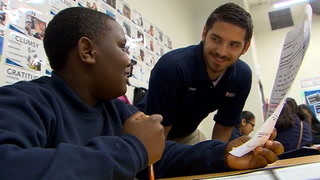
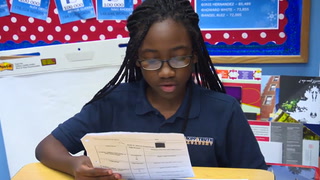
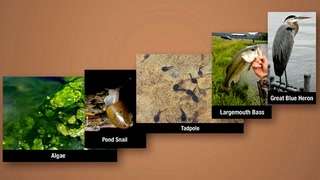
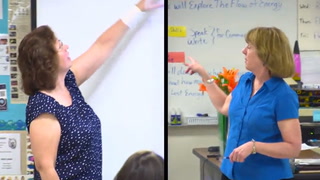


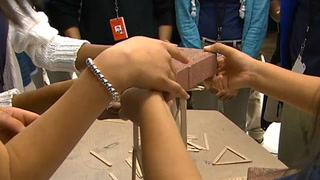
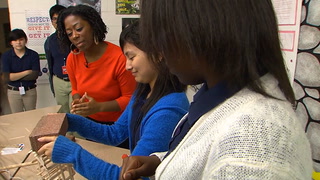


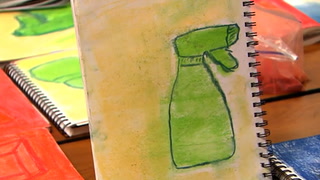
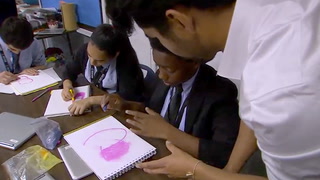
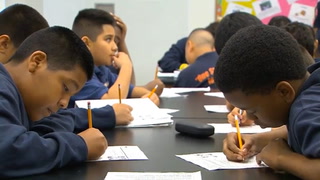
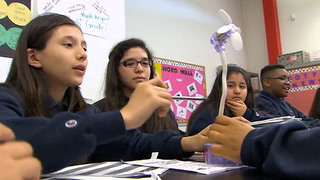









19 Comments
Ryan Cantrell Jul 28, 2020 10:07am
Ms. McCoy had to have placed specific classroom procedures and roles to ensure games went smoothly. The game allowed the students to reiterate what they learned in paper in a fun and interactive way. During the game, the teacher continuously reminded them what the rules are and that energy is depleted when meeting someone, they must refuel before moving on.
Leslie Jensen Mar 6, 2019 6:56pm
I want to do this lesson but where do I get the plan from?
Leslie Jensen
Stephanie DeShazo Jan 25, 2019 10:20am
Making sure I understand the directions. During the game each organism ONLY gained energy from one other organism they consumed, so if they met an organism they did not consume ie. heron and snail, do they just put beans in the waste bucket and do not exchange beans between each other?
Sylvia Jackson Jun 26, 2018 5:34pm
Joshua Lembeck Feb 22, 2018 10:01pm